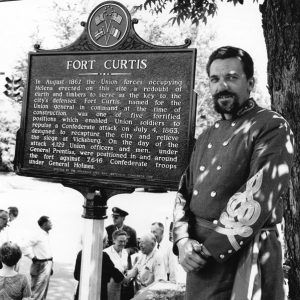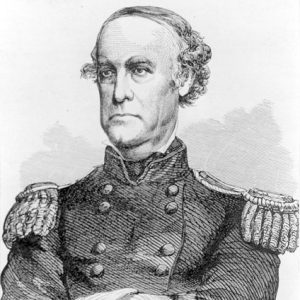calsfoundation@cals.org
Samuel Ryan Curtis (1805–1866)
Samuel Ryan Curtis was the Union general responsible for the victory at the Battle of Pea Ridge, the capture of Helena (Phillips County), and the repulse of Price’s 1864 invasion of Missouri and Kansas during the Civil War.
Samuel Curtis was born on a farm in Clinton County, New York, on February 3, 1805, to Zarah and Phalley Yale Curtis prior to the family’s move to Licking County, Ohio. He married Belinda Buckingham in 1831. The couple had six children.
A West Point graduate (1831), Curtis resigned his commission in June 1832. During his civilian life, Curtis served as an engineer for the Muskingum River and the Des Moines River improvement projects, the National Road, and the city of St. Louis, Missouri. Admitted to the Ohio bar, he also served as the mayor of Keokuk, Iowa, and as a three-term congressman from the First Congressional District of Iowa. A promoter of the American Central Railroad, his railroad experience gained him an appointment to the Select Committee on the Pacific Railroad prior to the Civil War.
Due to his past military experience, Curtis commanded a volunteer militia, the Mansfield Blues, in Ohio. When the Mexican War began, Curtis became the adjutant general of Ohio before assuming the colonelcy of the Third Ohio Volunteer Infantry. While not engaging in combat, he performed occupation duties in the Mexican towns of Matamoras, Camargo, Monterey, and Saltillo.
When the Civil War began, Curtis was elected colonel of the Second Iowa Infantry. At the request of General Nathaniel Lyon, he quickly marched this regiment to occupy Hannibal, Missouri, an action that led to his promotion to brigadier general in May 1861. Throughout the remains of 1861, he commanded the training at Jefferson Barracks, Camp Benton, and the defenses in St. Louis.
Given the command of the Southwestern District of Missouri, Curtis forced Confederate major general Sterling Price’s army from Missouri in February 1862. Pursuing him into Arkansas, Curtis’s men skirmished with the Confederates at the Big Sugar Creek on February 16, 1862. The next day, Curtis’s forces officially entered Arkansas following the Telegraph Road. This southward pursuit of Price extended his supply lines and forced a halt in northwest Arkansas to wait for much-needed supplies and to forage.
Confederate major general Earl Van Dorn, the overall Arkansas commander, abandoned plans to invade Missouri due to Curtis’s movement into northwestern Arkansas. Rushing there, Van Dorn personally took command of the Confederate forces, rapidly marching these men toward Curtis’s position. Curtis detected the arrival of the Confederates near Bentonville (Benton County) on March 6 and deployed his command along the Little Sugar Creek. Van Dorn recognized the tactical advantage of Curtis’s position and refused frontal assault, instead force-marching his exhausted men around the Federal right, moving one force in front of Big Mountain and the other behind it, planning to rejoin them and attack the Federal rear down Telegraph Road. Poor weather, fatigue, and road obstacles gave Curtis time to react. In a spectacular move, he completely turned his army around and then deployed forces to counter the separate Confederate columns. At first, the superior Confederate numbers stunted the Federal move, but the Federals took advantage of confusion created by the deaths and capture of several key Confederate leaders to slow the advance. During the night of March 7 and the early morning of March 8, Curtis reorganized his fatigued army using the Telegraph Road as its rough center. When Van Dorn did not aggressively attack the next morning, Union artillery pounded the Confederate positions prior to an assault by the Federal infantry toward Elkhorn Tavern. Van Dorn found his position untenable and withdrew. Curtis had won the Battle of Pea Ridge, a critical victory preventing further serious threats to Missouri and bolstering Union support in northwest Arkansas. He was promoted to major general in late March 1862.
Withdrawing toward better supply at Springfield, Missouri, Curtis monitored Van Dorn’s movement east of the Mississippi River. Now unchallenged, the Union army occupied Batesville (Independence County) in May 1862. From this point, Curtis divided his force into three divisions, placing additional occupying forces at Searcy (White County) and Jacksonport (Jackson County). Although his original target was Little Rock (Pulaski County), horrible roads, bad logistics, guerrilla resistance, and the loss of communication with command changed Curtis’s objective. Abandoning Batesville, he cut his supply lines and marched forward hoping to find supply ships on the lower White River. Early resistance at St. Charles (Arkansas County) and low water at Clarendon (Monroe County) prevented the fleet from supplying Curtis’s army. Discouraged, his men slogged through the barren Delta, which had been stripped clean by Confederate major general Thomas Hindman’s men. After an arduous march, the Union army arrived at Helena on July 12.
While occupying Helena, Curtis became embroiled in controversies. Curtis’s men had liberated numerous slaves without orders. As a large number of them had followed the army to Helena, Curtis was accused of supporting illegal cotton sales to purchase food for the ever-growing mass of liberated slaves there. While taking leave to organize a railroad convention, he found himself removed from field command, only to be elevated to commander of the Department of Missouri. Dealing with more politics and planning, Curtis quickly made enemies, including Governor Hamilton Rowan Gamble of Missouri, and lost his position on May 22, 1863.
In January 1864, he was given command of the Department of Kansas. Considered a lackluster assignment, it became critical in repulsing Price’s 1864 invasion of Missouri and Kansas. Summoning the state militia, Curtis defeated Price at the Battle of Westport, Missouri, and pursued him as far as the Arkansas River Valley, marching over the old Pea Ridge battlefield. Despite his victory, Curtis was reassigned to the Department of the Northwest on January 30, 1865.
After the war, Curtis served as an Indian commissioner and government consultant concerning the track constructed by the Union Pacific Railroad. He died on December 26, 1866, while inspecting the Union Pacific Railroad track near Council Bluff, Iowa. He is buried in Oakland Cemetery, Keokuk, Iowa.
For additional information:
Beckenbaugh, Terry Lee. “The War of Politics: Samuel Ryan Curtis, Race and the Political/Military Establishment.” PhD diss., University of Arkansas, 2001.
DeBlack, Thomas A. With Fire and Sword: Arkansas, 1861–1874. Fayetteville: University of Arkansas Press, 2003.
Gallaher, Ruth. “Samuel Ryan Curtis.” The Iowa Journal of History and Politics 25 (July 1927): 331–358.
Shea, William L. Union General: Samuel Ryan Curtis and Victory in the West. Lincoln, NE: Potomac Books, 2023.
Shea, William L., and Earl J. Hess. Pea Ridge: Civil War Campaign in the West. Chapel Hill: University of North Carolina Press, 1992.
Derek Allen Clements
Pocahontas, Arkansas
 Fort Curtis
Fort Curtis Military
Military Battle of Helena Monument
Battle of Helena Monument  Samuel Curtis
Samuel Curtis  Samuel Curtis
Samuel Curtis  General Samuel Curtis
General Samuel Curtis  Fort Curtis
Fort Curtis 



Comments
No comments on this entry yet.